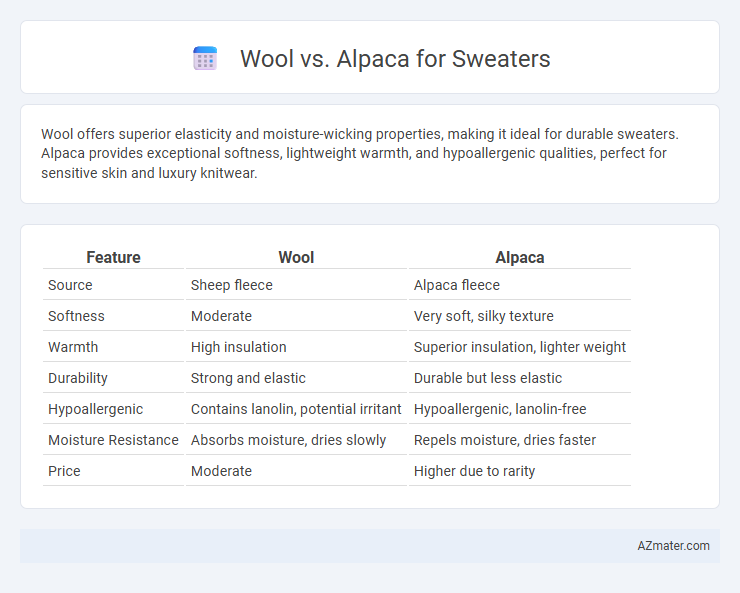Wool offers superior elasticity and moisture-wicking properties, making it ideal for durable sweaters. Alpaca provides exceptional softness, lightweight warmth, and hypoallergenic qualities, perfect for sensitive skin and luxury knitwear.
Table of Comparison
| Feature | Wool | Alpaca |
|---|---|---|
| Source | Sheep fleece | Alpaca fleece |
| Softness | Moderate | Very soft, silky texture |
| Warmth | High insulation | Superior insulation, lighter weight |
| Durability | Strong and elastic | Durable but less elastic |
| Hypoallergenic | Contains lanolin, potential irritant | Hypoallergenic, lanolin-free |
| Moisture Resistance | Absorbs moisture, dries slowly | Repels moisture, dries faster |
| Price | Moderate | Higher due to rarity |
Overview: Wool vs Alpaca Sweaters
Wool sweaters offer excellent insulation, durability, and moisture-wicking properties, making them a popular choice for cold weather. Alpaca sweaters provide superior softness, hypoallergenic qualities, and lightweight warmth due to the fine fibers of alpaca fleece. Both materials excel in thermal regulation, but alpaca fibers tend to resist pilling and odors better than traditional wool.
Key Differences Between Wool and Alpaca
Wool fibers are coarser and tend to retain moisture, making wool sweaters highly durable and moisture-wicking, while alpaca fibers are finer, smoother, and naturally hypoallergenic, offering superior softness and warmth without itchiness. Alpaca fibers have a hollow core, providing better insulation and lightweight warmth compared to the denser wool fibers, which trap heat more slowly. Wool is generally more elastic and resilient to wear and tear, whereas alpaca sweaters excel in lightweight comfort and resistance to pilling.
Softness and Comfort Comparison
Alpaca fibers are finer and smoother than wool, resulting in a sweater that feels exceptionally soft against the skin, reducing itchiness commonly associated with wool. Wool provides excellent warmth and elasticity, but its coarser texture can sometimes cause irritation for sensitive skin. Choosing alpaca sweaters often enhances comfort levels due to their lightweight, hypoallergenic properties and superior softness compared to traditional wool garments.
Warmth and Insulation Properties
Alpaca fibers provide superior warmth and insulation compared to traditional wool due to their hollow-core structure, which traps heat more efficiently. Wool offers excellent moisture-wicking and breathability, helping regulate body temperature but may feel heavier than alpaca. For sweater insulation, alpaca delivers lightweight warmth and exceptional softness, making it ideal for cold climates without bulk.
Breathability and Moisture Wicking
Alpaca fiber offers superior breathability compared to traditional wool, allowing for better air circulation and temperature regulation in sweaters. Its natural moisture-wicking properties efficiently draw sweat away from the skin, keeping the wearer dry and comfortable during physical activity or fluctuating temperatures. Wool also provides good breathability and moisture management but tends to retain more moisture, making alpaca an ideal choice for enhanced comfort in sweaters.
Durability and Longevity
Wool sweaters exhibit high durability due to their resilient fiber structure, resisting wear and tear over extended use. Alpaca fibers, while softer and hypoallergenic, offer superior longevity as they are naturally resistant to pilling and moisture absorption, maintaining fabric integrity longer. Both materials provide lasting warmth, but alpaca's blend of strength and softness often results in a more durable sweater that ages gracefully.
Allergy and Sensitivity Factors
Alpaca fibers are hypoallergenic, containing no lanolin, making them ideal for individuals with wool allergies or sensitive skin. Wool often causes irritation or itching due to its lanolin content and coarser texture, which can trigger allergic reactions in sensitive users. Choosing alpaca sweaters reduces the risk of rashes and discomfort, offering a soft, breathable alternative for allergy-prone wearers.
Sustainability and Ethical Considerations
Alpaca fiber is considered more sustainable than traditional wool due to its lower environmental impact, requiring less water and producing less methane during farming. Wool harvesting can sometimes involve practices like mulesing, raising ethical concerns, whereas alpaca farming typically supports animal welfare with less invasive methods. Both fibers are biodegradable and renewable, but alpaca's sustainable traits and ethical treatment often make it a preferred choice for eco-conscious sweater production.
Care and Maintenance Tips
Wool sweaters require regular gentle washing with cold water and mild detergent to maintain fiber integrity, avoiding high heat that can cause shrinking or felting. Alpaca sweaters benefit from less frequent washing due to their natural resistance to odors and dirt, and should be hand-washed or dry cleaned to preserve softness and prevent damage. Proper flat drying away from direct sunlight ensures both wool and alpaca sweaters retain shape and durability over time.
Final Verdict: Choosing the Best Sweater Material
Wool sweaters offer excellent warmth and durability, making them ideal for cold weather and robust wear, while alpaca sweaters provide superior softness, hypoallergenic properties, and lightweight insulation, suitable for sensitive skin and milder climates. Alpaca fibers tend to resist pilling and moisture better than wool, enhancing comfort and longevity in everyday use. Choosing between wool and alpaca depends on the desired balance between rugged durability and luxurious softness, with alpaca favored for premium comfort and wool for traditional warmth and resilience.

Infographic: Wool vs Alpaca for Sweater
 azmater.com
azmater.com